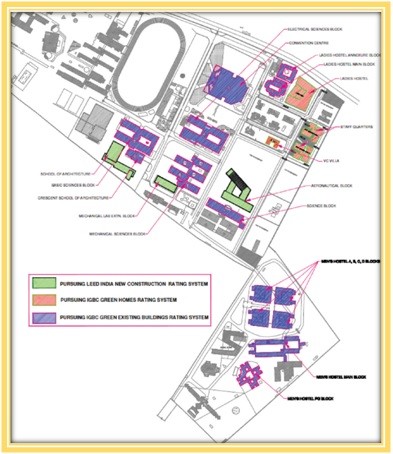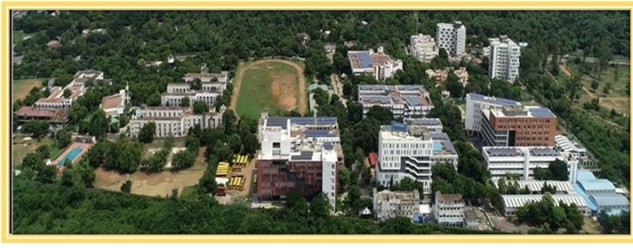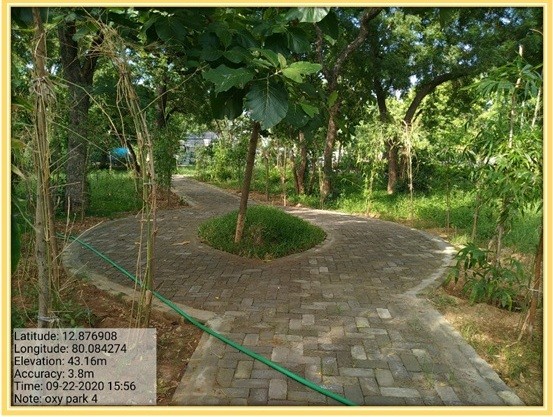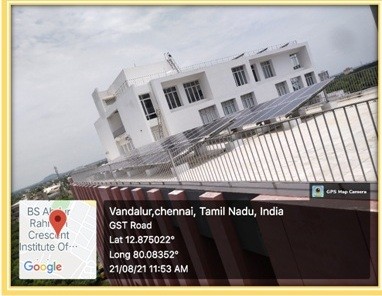Environmental Impact
BSACIST'S SCOPE 1 & 2 EMISSIONS: A COMMITMENT TO SUSTAINABILITY
B. S. Abdur Rahman Crescent Institute of Science and Technology (BSACIST) demonstrates a strong commitment to environmental sustainability through its comprehensive carbon management strategy. The institute diligently tracks and manages its Scope 1 and Scope 2 emissions, adhering to the GHG Protocol Corporate Standard. This commitment is evident in the detailed accounting of emissions from direct sources, such as diesel generators (Scope 1), and indirect sources, like purchased electricity (Scope 2). BSACIST aims to minimize its environmental impact and contribute to a healthier planet by meticulously monitoring these emissions.
The institute’s Scope 1 emissions, stemming from generator diesel consumption, amount to 77.65 tonnes of CO2 equivalent (tCO2e) per year. This figure is calculated based on a total diesel consumption of 28,975 litres annually, using a conversion factor of 2.68 kg of CO2 per litre of diesel. Scope 2 emissions, arising from the purchase of electricity from the grid, are significantly higher at 3348.32 tCO2e per year. This is derived from an annual electricity consumption of 4,083,312 kWh, with a CO2 emission factor of 0.82 kg CO2 per kWh, as per the Central Electricity Authority (CEA) data for the Indian grid.
The total Scope 1 and Scope 2 emissions for BSACIST amount to 3425.97 tCO2e per year. This figure represents the sum of direct emissions from diesel generators and indirect emissions from purchased electricity. The institute’s commitment to reducing these emissions is reflected in its various sustainability initiatives, including the adoption of energy-efficient technologies, the implementation of green infrastructure, and the promotion of eco-friendly transportation options. These efforts aim to minimise the institute’s carbon footprint and contribute to a more sustainable future.
BSACIST’s approach to carbon management extends beyond mere accounting of emissions. The institute actively invests in green infrastructure, such as tree-covered areas and Beema Bamboo plantations, which absorb 747 tons of CO2 annually, offsetting 10.13% of total carbon emissions. Additionally, the installation of 650 kWp of solar photovoltaic plants across campus buildings offsets approximately 474 tons of CO2 emissions annually, equivalent to planting 21,545 trees. These initiatives demonstrate BSACIST’s proactive approach to reducing its carbon footprint and promoting environmental stewardship.
BSACIST’s comprehensive carbon management strategy, characterized by meticulous tracking of Scope 1 and Scope 2 emissions and investments in green infrastructure and energy-efficient technologies, underscores its commitment to sustainability. By adhering to the GHG Protocol Corporate Standard and actively pursuing emission reduction initiatives, BSACIST sets a benchmark for other institutions in higher education to follow in pursuing a greener and more sustainable future.
A. Transforming BSACIST: Upgrading Existing Buildings for Enhanced Energy Efficiency
COMMITMENT TO UPGRADING ENERGY EFFICIENCY
The initiative to upgrade existing buildings to higher energy efficiency is a cornerstone of sustainable development at B. S. Abdur Rahman Crescent Institute of Science and Technology (BSACIST). This commitment aligns with the broader definition of sustainability, which emphasizes meeting present needs without compromising future generations’ ability to meet theirs. By focusing on energy-efficient upgrades, BSACIST aims to minimize its environmental impact, reduce operational costs, and enhance the overall quality of life for its occupants. The university recognizes that the built environment significantly influences energy consumption and resource use, making these upgrades essential for fostering a sustainable campus.
COMPREHENSIVE SUSTAINABILITY MEASURES
BSACIST’s approach to upgrading buildings encompasses a wide range of sustainability measures that address various aspects of energy efficiency. The campus incorporates advanced technologies such as high-performance insulation, energy-efficient Heating, Ventilation, and Air Conditioning (HVAC) systems, and renewable energy investments, including solar panels. These upgrades are designed to reduce energy consumption significantly, with comprehensive simulation studies indicating potential reductions of up to 10.5% in energy use across various buildings. The integration of these technologies not only lowers energy costs but also contributes to the university’s goal of achieving a “Net Zero Energy Building,” where energy generation meets or exceeds consumption.
WATER AND RESOURCE EFFICIENCY
In addition to energy efficiency, BSACIST emphasizes water conservation and resource management as part of its sustainability upgrades. The implementation of rainwater harvesting systems and on-site wastewater treatment facilities exemplifies the university’s commitment to responsible water use. By treating 100% of wastewater on-site and utilizing it for flushing and irrigation, BSACIST effectively reduces its reliance on external water sources. Furthermore, the selection of native and adaptive landscaping species minimizes water requirements, showcasing a holistic approach to resource management that complements energy efficiency efforts.
ENHANCING INDOOR ENVIRONMENT QUALITY
Upgrading buildings for higher energy efficiency also involves improving indoor environmental quality. BSACIST has adopted measures to ensure that indoor air quality is prioritized, including the use of low volatile organic compounds materials, adequate ventilation, and natural lighting. These enhancements not only contribute to energy savings but also promote the health and well-being of students and staff. By creating spaces that are conducive to learning and productivity, the university fosters an environment where occupants can thrive, thereby enhancing overall performance and satisfaction.
A VISION FOR A SUSTAINABLE FUTURE
In summary, BSACIST’s plans to upgrade existing buildings to higher energy efficiency reflect a comprehensive commitment to sustainability. By integrating energy-efficient technologies, water conservation practices, and indoor environmental quality measures, the university is setting a benchmark for sustainable practices in higher education. This proactive approach not only reduces the ecological footprint of the campus but also serves as a model for other institutions aiming to achieve similar sustainability goals. As BSACIST continues to invest in these initiatives, it reinforces its vision of transforming the campus into a green, sustainable environment that benefits both current and future generations.
ENHANCED ENERGY EFFICIENCY – CAMPUS DEVELOPMENT PLAN
Commitment to Sustainable Practices
Upgrading existing buildings to higher energy efficiency is a critical step in fostering sustainable practices within campus environments. The initiative transcends mere compliance with regulatory requirements; it embodies a strategic commitment to minimizing the environmental impact of our university infrastructure. By leveraging modern engineering and sustainable materials, institutions can significantly reduce energy consumption, thus lowering greenhouse gas emissions and contributing to a healthier environment for current and future generations.
Campus Map of Energy Efficiency Initiatives


Strategic Planning for Energy Efficiency
The BSACIST campus layout, as depicted in the accompanying map, reflects a meticulous strategy for implementing energy-efficient upgrades. Key buildings, including the Crescent School of Architecture, Basic Science Block, and Mechanical Science Block, are categorized according to their engagement with various sustainability rating systems, such as the Leadership in Energy and Environmental Design (LEED) India New Construction Rating System and the IGBC Green Homes and Green Existing Buildings Rating Systems. This distinct colour coding not only clarifies each building’s status but also underscores the university’s commitment to integrating sustainable practices throughout its operations.
Forward-Thinking New Constructions
Buildings within the LEED rating system, such as the KBA Men’s Hostel (Phase II) at BSACIST, represent a progressive approach to construction. By prioritizing energy efficiency, waste reduction, and the use of sustainable materials from the outset, these structures establish benchmarks for future projects. This proactive strategy not only lowers operational costs but also enhances the living and learning environments for students and faculty, promoting a culture of sustainability across the campus.
Renovating Older Infrastructure
The IGBC Green Existing Buildings rating system highlights the university’s commitment to modernizing older infrastructures, such as the Electrical Science Block, Convention Center, Ladies Hostel, and Quarters. This initiative involves assessing and retrofitting these spaces with energy-efficient technologies, breathing new life into them while significantly lowering their ecological footprints. These upgrades not only enhance operational efficiency but also serve as exemplary models of how institutions can honor their heritage while embracing contemporary sustainability standards.
A Legacy of Environmental Stewardship
In conclusion, the strategic planning for energy efficiency at BSACIST illustrates a comprehensive commitment to sustainability across new and existing infrastructures. By integrating energy-efficient practices and sustainable materials, the university not only enhances its buildings but also fosters a culture of environmental responsibility. The careful categorization of projects under various sustainability rating systems, combined with proactive measures for both new constructions and the retrofitting of older buildings, establishes BSACIST as a leader in sustainable practices within higher education. This holistic approach not only reduces operational costs but also creates a vibrant and environmentally conscious campus, setting a standard for others to follow in the pursuit of sustainability.
B. Carbon Neutrality at BSACIST: A Comprehensive Approach to Sustainable Campus Management
Benchmarking Carbon Efficiency:
Redefining Institutional Environmental Performance B. S. Abdur Rahman Crescent Institute of Science and Technology (BSACIST) has implemented a comprehensive carbon management strategy that significantly reduces its carbon footprint through innovative and sustainable practices. The institute’s total carbon emission stands at 7,369 tons per year, with a per capita carbon footprint of 1.05 tons, which is remarkably lower than the national average of 1.58 tons per capita. This represents a 33.54% reduction from the national average, demonstrating the institution’s commitment to environmental sustainability and carbon reduction.
Green Infrastructure – Strategic carbon offsetting through Ecological Interventions:
The carbon offsetting strategy at BSACIST is multifaceted, leveraging green areas and renewable energy initiatives to mitigate carbon emissions. The campus boasts 19 acres of green spaces, including tree-covered areas, lawns, and Beema Bamboo plantations, which collectively absorb 747 tons of CO2 annually. This represents 10.13% of the total carbon emissions, with the green areas covering 37.86% of the campus. The solar infrastructure plays a crucial role in this carbon reduction effort, with 650 kWp of solar photovoltaic plants installed across campus buildings, offsetting approximately 474 tons of CO2 emissions annually – equivalent to planting 21,545 trees.

Green Areas – 19 Acres (37.86% of the Total Campus)

Beema Bamboo Plantations

Installed Roof Top Solar Power Plants
Emission Management : Integrated Technological and Operational Strategies
The institute’s carbon management approach extends beyond green spaces and solar energy. The comprehensive strategy includes multiple energy-efficient technologies and sustainable practices across various campus operations. Transportation emissions are carefully managed, with detailed tracking of petrol and diesel consumption. Electricity consumption, which accounts for the largest portion of carbon emissions (5,251,791 kg CO2), is being systematically reduced through energy-efficient technologies, including high-performance building envelopes, efficient lighting systems, and advanced HVAC technologies. The institute has also implemented water conservation measures and waste management strategies that contribute to overall carbon reduction.
Innovative Technologies and Collaborative Sustainability : Beyond Traditional Approaches
Innovative technologies and collaborative approaches further enhance BSACIST’s carbon management efforts. The implementation of zero-export devices for solar power management, solar water heating systems, and energy-efficient building designs demonstrate a holistic approach to sustainability. The solar water heating systems, with a total capacity of 39,500 litres, are estimated to save approximately 24 lakhs in power consumption annually. Additionally, student-driven projects, such as solar street lighting installations, showcase the institute’s commitment to engaging the academic community in sustainable practices.
Driving Sustainability: The Role of Eco-Friendly Vehicles in BSACIST’s Green Transportation Initiative
The integration of eco-friendly vehicles into the university’s transportation system highlights a practical application of BSACIST’s sustainability values, encouraging a shift toward cleaner mobility solutions while reducing overall campus emissions.
Eco-Friendly Conveyance @ Crescent

C. SCOPE 1 AND 2 CO2 EMISSIONS SUMMARY
SCOPE 1 EMISSIONS (FROM DIESEL GENERATORS):
• Total DG consumption: 28,975 litres per year
• To convert diesel consumption to CO2 emissions, we use the Conversion factor: 1 litre of diesel produces approximately 2.68 kg of CO2.
• CO2 emissions from DG sets = 28,975 liters * 2.68 kg CO2/liter = 77,653 kg
CO2 = 77.65 tonnes of CO2.
SCOPE 2 EMISSIONS (FROM PURCHASED ELECTRICITY):
• Total EB (Electricity Board) consumption: 4,083,312 kWh per year.
• According to the latest data from the Central Electricity Authority (CEA), the CO2 emission factor for the Indian grid is approximately 0.82 kg CO2/kWh.
• CO2 emissions from purchased electricity = 4,083,312 kWh * 0.82 kg CO2/kWh = 3,348,316 kg CO2 = 3348.32 tonnes of CO2.
TOTAL SCOPE 1 AND 2 EMISSIONS:
• Total CO2 emissions = Scope 1 emissions + Scope 2 emissions
• Total CO2 emissions = 77.65 tonnes + 3348.32 tonnes = 3425.97 tonnes of CO2e
Therefore:
• Scope 1 Emissions: 77.65 tCO2e
• Scope 2 Emissions: 3348.32 tCO2e
• Total Scope 1 and 2 Emissions: 3425.97 tCO2e


